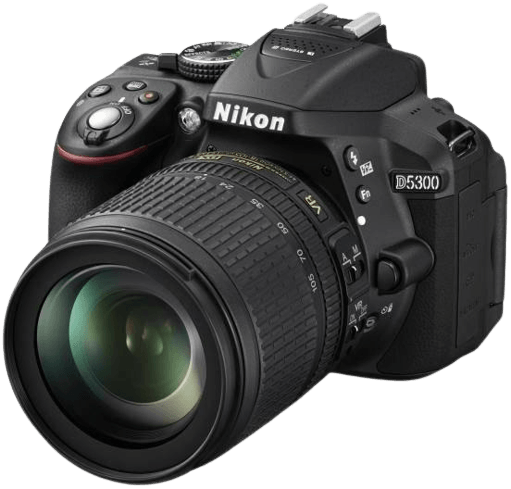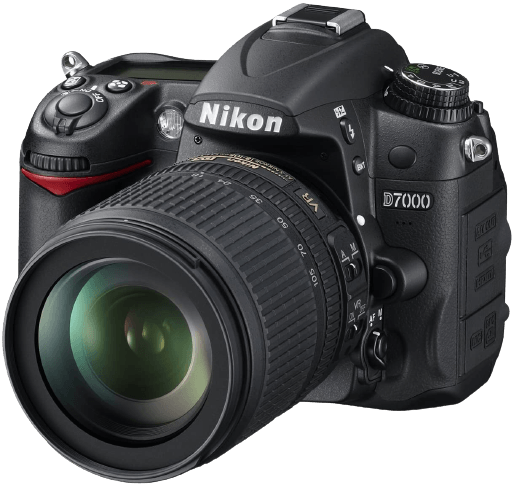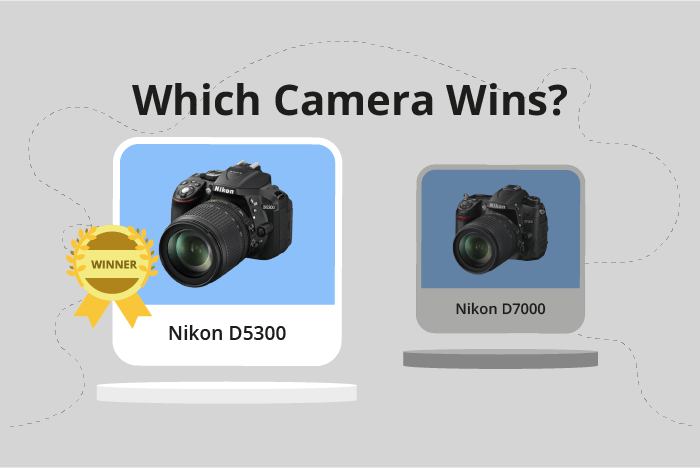Nikon D5300 vs D7000 Comparison
Nikon D5300

Nikon D7000

The Nikon D5300 emerges as the winner with a score of 57/100, compared to the Nikon D7000‘s score of 56/100. Both cameras are DSLRs and share some common specifications, such as the same launch price and camera type. However, the D5300 has a few advantages over the D7000.
The D5300 is lighter, weighing 480g or 1.06lbs, making it more convenient for carrying around. Additionally, its smaller size (125 x 98 x 76mm) further contributes to its portability. These features make the D5300 a better option for those prioritizing ease of use and mobility.
On the other hand, the Nikon D7000 has a slightly larger size (132 x 105 x 77mm) and weighs more (780g or 1.72lbs). This might appeal to photographers who prefer a more substantial feel to their camera, but it does not offer any significant advantages in terms of performance.
Taking all factors into consideration, the Nikon D5300’s higher score reflects its superior portability and ease of use, while the Nikon D7000’s advantages are limited to its more substantial build.
Nikon D5300 vs D7000 Overview and Optics
The Nikon D5300 outperforms the Nikon D7000 in optics, scoring 65/100 compared to the D7000’s 55/100. Both cameras share some common specifications, such as the CMOS sensor type, APS-C sensor size, Nikon F lens mount, and the lack of image stabilization.
The D5300 has a higher megapixel count of 24.2, compared to the D7000’s 16.2, which allows for more detailed and sharper images. Additionally, the D5300 is equipped with a superior processor, the Expeed 4, which results in better image processing and overall performance. The DXOMARK score for the D5300’s sensor is also higher at 83, compared to the D7000’s 80, indicating better sensor quality.
On the other hand, the Nikon D7000 has a faster shooting speed of 6 frames per second, compared to the D5300’s 5 frames per second. This advantage allows the D7000 to capture fast-moving subjects more effectively.
Considering these factors, the Nikon D5300 is better suited for photographers who prioritize image quality and detail, while the Nikon D7000 may be more appropriate for those who need a faster shooting speed for action photography. However, both cameras possess a strong set of optics features, making them suitable choices for various photography styles and needs.
Nikon D5300 vs D7000 Video Performance
The Nikon D5300 is the winner in video capabilities, scoring 70 out of 100, while the Nikon D7000 scores 57. Both cameras have Full HD video resolution, with maximum dimensions of 1920 x 1080, and time-lapse functionality built-in. However, the D5300 surpasses the D7000 in certain aspects, making it a better choice for video recording.
One significant advantage of the D5300 is its higher maximum video frame rate of 60fps, compared to 24fps in the D7000. This allows for smoother and more detailed video capture, especially in fast-moving scenes. The higher frame rate also offers greater flexibility in post-production, enabling users to create slow-motion effects without loss of quality.
While the D7000 does not surpass the D5300 in video capabilities, it still offers decent video quality with Full HD resolution and time-lapse functionality. For users who do not require the higher frame rate, the D7000 could be a suitable option.
Taking these points into account, the Nikon D5300 stands out as the superior choice for video capabilities due to its higher frame rate. The D7000, although lacking in this aspect, remains a viable option for those who prioritize other features or have a lower budget. Ultimately, the choice between the two cameras depends on individual preferences and requirements.
Nikon D5300 vs D7000 Features and Benefits
The Nikon D7000 outperforms the Nikon D5300 with a feature score of 54/100 compared to 46/100. Despite this difference, both cameras share some specifications, including the absence of a touchscreen and Bluetooth. Additionally, both models offer WiFi connectivity, allowing for simple sharing and remote control.
The D7000 excels in several aspects. Although its screen size is slightly smaller at 3 inches compared to the D5300’s 3.2 inches, it compensates with a higher overall feature score. This advantage suggests that the D7000 offers more features and capabilities than its counterpart. However, it is crucial to consider individual preferences and specific needs when evaluating the cameras’ features.
On the other hand, the Nikon D5300 offers some unique features. It has a flip screen, which allows for more versatile shooting angles and is particularly useful for vlogging or capturing images from challenging positions. Moreover, the D5300 is equipped with GPS, enabling users to geotag their photos with location data, a feature the D7000 lacks.
In comparing these two cameras, it is evident that the Nikon D7000’s higher feature score signifies a more versatile camera, but the Nikon D5300’s unique features should not be overlooked. The D5300’s flip screen and GPS capabilities cater to specific needs that some users may prioritize. Ultimately, the choice between these two cameras depends on individual preferences and requirements, taking into account the advantages and disadvantages of each model.
Nikon D5300 vs D7000 Storage and Battery
The Nikon D7000 outperforms the Nikon D5300 in storage and battery, scoring 79/100 compared to the D5300’s 29/100. Both cameras share common specifications, such as accepting SD, SDHC, and SDXC memory cards. The D5300 has only one memory card slot, however.
The D7000 boasts a superior battery life, with 1050 shots on a single charge, using the EN-EL15 battery type. This is a significant advantage over the D5300’s 600 shots with its EN-EL14a battery. This longer battery life makes the D7000 more suitable for extended shooting sessions without the need for frequent battery replacement or charging.
Although the D5300 has a lower score in storage and battery, it still provides a decent battery life of 600 shots, which may be sufficient for casual users or those who do not require extended shooting time.
Taking these factors into account, the Nikon D7000 is the clear winner in storage and battery performance, making it a better choice for photographers requiring longer battery life. However, the Nikon D5300 still offers adequate battery life for casual users, and its lower score should not deter those who prioritize other features.
Alternatives to the Nikon D5300 and D7000
Are you still undecided about which camera is right for you? Have a look at these popular comparisons that feature the Nikon D5300 or the Nikon D7000:

